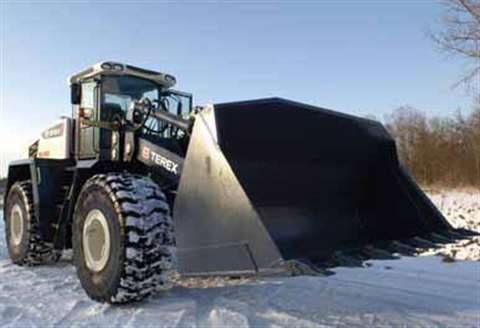Growth from within
24 April 2008

Terex has a History as the most acquisitive player in the construction equipment industry. This aggressive and sometimes audacious strategy has seen it grow from the brink of ruin in the early 1990s to its current position as the clear number three in the global industry, with annual sales in excess of US$ 6,4 billion (€ 5,25 billion).
But having established a fairly full product range through its previous acquisitions, these days see Terex put more emphasis on renewing and improving its range through &organic' means.
Take for example, one long- standing pillar of the company's product mix - articulated dump trucks (ADTs). New designs for its TA35 and TA40 ADTs extend the capacities of the Generation 7 series to 21 and 23,3 m3 - up 1,5 and 1,3 m3 respectively. This translates to a 32 tonne capacity for the TA35, and 36 tonnes for the TA40 - both 2 tonnes more than their predecessors.
In addition to the capacity increases, the use of Detroit Diesel Series 60 engines have increased the top speed - now 60 km/h for the TA40, and this truck is also available with an ejector body, which pushes the payload out without the need to raise the body.
However, it was transmission, not engine, selection that was central to bringing the truck to reality.“Finding a suitable transmission was critical to the design effort”, said chief engineer Paul Douglas.“We selected the Allison HD465 automatic, already proven in our 35 tonne rigid truck, and designed around it.”
The designers in Motherwell, UK have also devoted attention to smaller members - the TA25, TA27 and TA30 - of the Generation 7. Models available from April will have higher capacities (13,5, 15,5, and 17,5 m3) and the TA27 and TA30 now feature engine (exhaust) retarders rather than transmission retarders, along with oil-immersed brakes.
The TA30 breaks new ground from June onwards with the option of independent front suspension, an industry first, according to Mr Douglas, and a productivity boost for users. “Keeping the wheels firmly positioned against the ground when at full speed and power allows 20% greater production,” he said.
Excavators & Loaders
Terex's new crawler excavators are the TC210, TC225, TC240 and TC260, weighing in at 21, 22,5, 24, and 26 tonnes respectively. Power comes from 6,7 litre Cummins QSB engines, rated from 104 to 125 kW, while the hydraulics are a seven- circuit (plus two optional) system from Rexroth.
Outside these popular weight classes, the company plans to add 33 and 35 tonne models, which should be available in the second half of this year, followed by 14 and 17 tonne machines in 2007.
However, the biggest crawler in Terex's near future will the 85 tonne TC850 quarry excavator, derived from the Terex O&K RH30 and is currently “under construction”. A 448 kW Cummins QSX powers this machine, which can be fitted with buckets from 5,5 to 7,0 m3.
The company's new wheeled loaders, the TL360, TL420, TL450, and TL510 (the numbers relate to bucket sizes - the TL360 has a 3,6 m3 bucket) weigh in between 23 to 30 tonnes, with Cummins engines rated from 180 to 250 kW. These models replace the Terex Kaelble range, which joined the Terex fold in 2004 with the acquisition of Kaelble, and all now feature ZF transmissions and axles.
Supplied Graders
The most recent addition to the Terex brand is a line of motor graders manufactured for it by HBM-Nobas of Germany under an OEM supply agreement reached last November. The four models, TG110, TG150, TG190, and TG210, take their names from their 11, 15, 19 and 21 tonne operating weights. The TG150 and 190 models are available now, and the 110 and 210 will follow in August.
Cummins engines deliver 100 to 170 kW of power through six forward and three reverse speed, powershift transmissions to NAF axles and Rexroth hydraulics. The grading equipment comprises 3,36 to 3,66 m long moldboards that swivel through 90° to a vertical position for grading of banks. The front dozer rotates 30° rotation to either side, and the machines can also be fitted with front and rear rippers, mid-mount scarifiers and V rippers.
OPERATOR COMFORT
Terex's new machines obviously span a huge range of weight classes and types, but the company is aiming for common standards of safety, comfort and serviceability Nearly all of Terex's new products have air-suspension seats, easy- access consoles, adjustable control lever arms, electronic equipment status displays, tinted glass, air conditioning, stereo systems, and large, newly designed, flat-floored cabs optimised for visibility.
Unifying design across the products, as well, is an emphasis on serviceability. Features such as tilt cabs, powered hood raising, swing- away access panels, ground level (or other easy) access to routine service points, and flat glass panels of cabs characterise most of the new products.
These machines lead the total of 17 new machines Terex plans to launch in 2006, following the 25 that came out last year. The new products reflect the company's efforts “...to bring all construction equipment together,” said Colin Robertson, corporate vice president of operations, as well as the company's hopes for continued sales growth.




